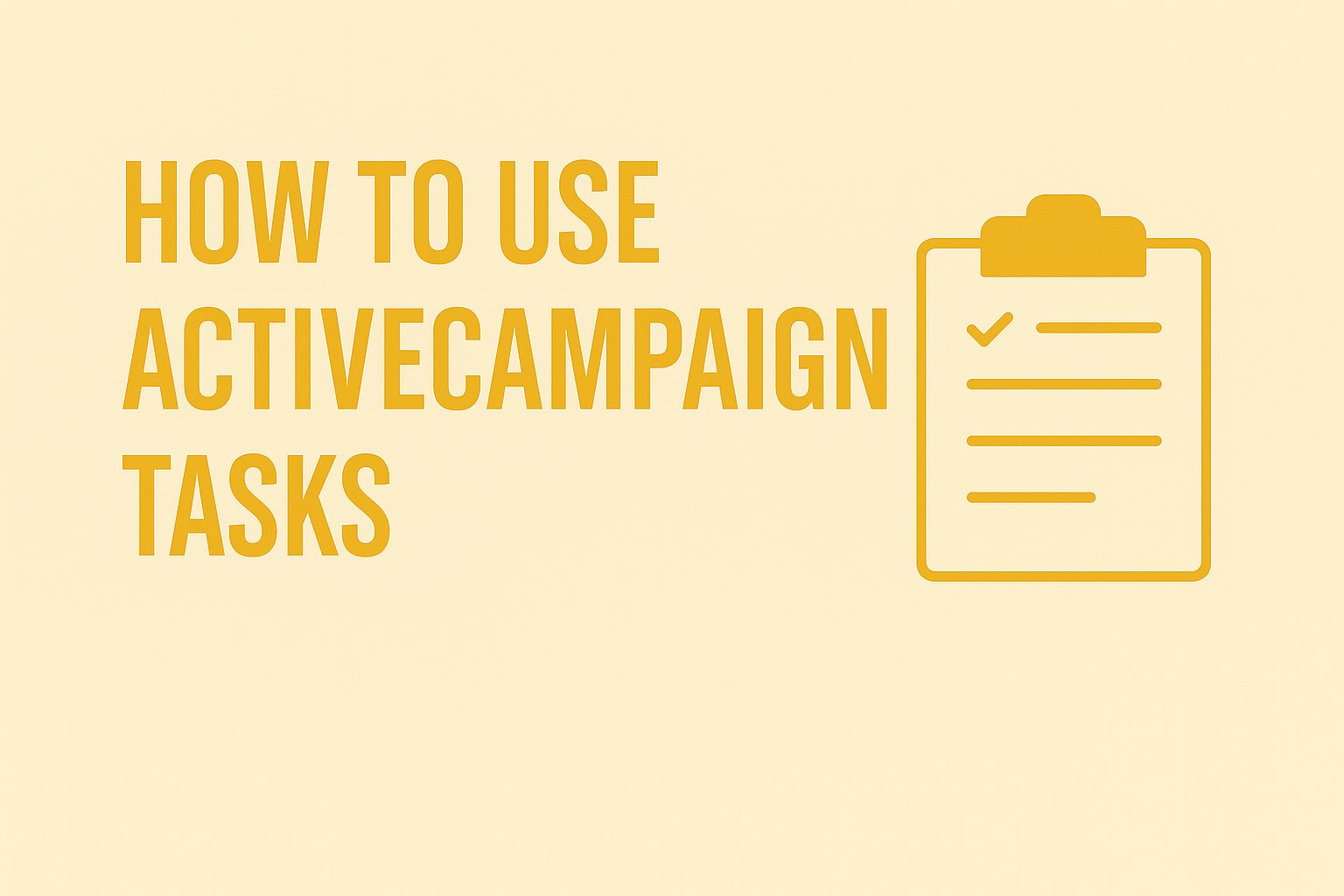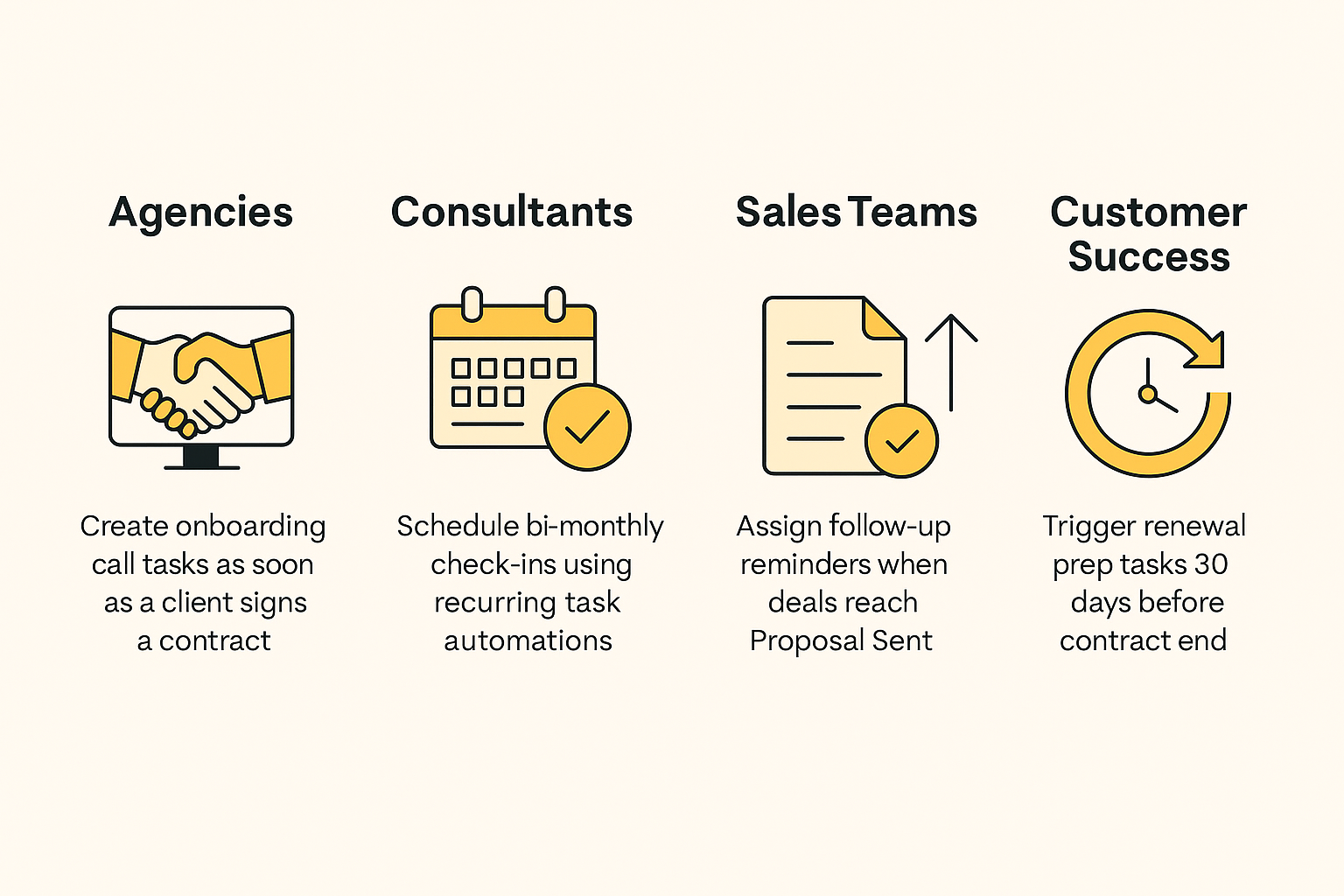How to Use ActiveCampaign Tasks to Streamline Sales and CRM
How do you start your day? Do you know exactly what needs your attention first?
When your inbox is overflowing and deals are piling up, even the best salespeople can lose track of what matters most. That’s where ActiveCampaign tasks come in.
Instead of jumping between inboxes and spreadsheets, tasks give your workflow a structured home inside your CRM. Used effectively, they can save you hours each week and keep your entire team aligned and accountable.
In this guide, we’ll walk through exactly how to use ActiveCampaign tasks to save time, automate follow-ups, and manage your CRM workflow effectively. Whether you're a solo founder or running a sales team, this article will give you practical steps and automation tips to make the most of the task feature.
👉 Watch this video on YouTube : How to Use Tasks in ActiveCampaign
In this video, you'll learn how to use ActiveCampaign Tasks to manage follow-ups, streamline your sales pipeline, and never miss a deal.
Key Takeaways
ActiveCampaign tasks let you track follow-ups, meetings, and emails directly inside deals or contact records.
You can filter, prioritise, and complete tasks daily from a single dashboard.
Automating task creation in pipelines saves hours and prevents deals from slipping through the cracks.
Tasks can be customised by type (call, email, meeting) and linked to reminders.
Using ActiveCampaign task management boosts conversion rates by ensuring timely outreach.
What Are Tasks in ActiveCampaign?
Tasks in ActiveCampaign act like a personal assistant for your sales CRM.
Each task is a scheduled action — a follow-up call, an email to send, a proposal to review.
These are linked to contacts or deals so your workflow stays connected to your sales pipeline. They appear on a single dashboard inside your Deals CRM, where you can filter by due date, type, or assigned user. This allows your team to prioritise what to do next, across every open opportunity.
With ActiveCampaign tasks, you remove guesswork.
Everyone knows what action comes next, and there’s no need to cross-check calendars or dig through email threads. You can assign tasks to yourself or delegate to others, set reminders, and include custom notes for context. These are especially powerful when combined with automation, which we’ll cover later. The real benefit? Predictable, repeatable sales processes that reduce stress and increase performance.
Why Task Management Matters in Sales
If you’ve ever lost a deal because someone forgot to follow up, you know the cost of poor task management. Manual systems like sticky notes or spreadsheets don’t scale. ActiveCampaign task management centralises and automates this process so your entire team works from one source of truth.
Task management matters because it closes the gap between intention and action.
Every sales strategy relies on consistent touchpoints — whether it's sending a quote or making a follow-up call. Tasks make this repeatable.
They let you assign responsibility, track completion, and measure outcomes. More importantly, they build habits across your team. For agencies and sales reps juggling dozens of deals, this visibility is essential. A clean, updated task list also gives managers insight into performance gaps and forecasting needs. It’s more than admin — it’s a strategic advantage.
Navigating Your Task Dashboard
Your task dashboard is the daily starting point.
Log into ActiveCampaign and head to "Deals > Tasks." Here, you’ll find a clear summary of everything that requires attention.
Start with overdue tasks — these are your immediate priorities.
2. Then work through tasks due today, which becomes your to-do list.
3. Finally, review upcoming tasks to prep ahead.
You can also filter by type (call, email, meeting) to batch work more efficiently. For example, you may want to make all your calls back-to-back or schedule emails after lunch. This reduces context switching and improves focus. Another tip: use the sort feature to organise by due date or task owner if working in a team. This dashboard becomes your single source of truth for what needs doing, who’s doing it, and by when. It’s the foundation of proactive sales execution.
Creating Tasks Manually on Contacts
You can create a task manually at the contact level. Here's how:
Go to a specific contact (e.g. Alex Pane), scroll to the "Tasks" section, and click Add a Task. You’ll then be prompted to fill in key fields:
Title (e.g. "Book onboarding session")
Task type (call, email, meeting, or custom)
Description (include prep details, context, or talking points)
Due date/time
Reminder notification (e.g. 1 hour before)
This workflow is ideal when you’re doing relationship-based outreach or manually managing key accounts. By attaching tasks to individual contacts, you maintain full visibility over every interaction. It also works well when reviewing campaign responses and you need to schedule personal follow-ups. The best part? These tasks sync directly into your daily dashboard and can be edited at any time if priorities shift.
Creating Tasks Manually on Deals
If you're working directly in the pipeline, you can also create tasks within a deal card. This is useful for aligning your to-do list with deal progress.
For example, if you're in the “Proposal Sent” stage, your next logical task might be "Call to review proposal."
To create a task inside a deal:
Open the deal card (e.g. “Q2 Proposal: ACME Corp”).
Go to the Open Tasks section.
Click Add Task.
Choose a title, type, and due date.
You can also assign the task, set reminders, and link any notes or documents. By keeping everything inside the deal view, you centralise your efforts. This way, nothing important is lost in email or chat.
Automating Task Creation (and Why You Should)
Manual tasks are great but automations are where ActiveCampaign tasks shine.
They eliminate human error, speed up execution, and maintain consistency at scale. Imagine this: Every time a lead fills out a high-intent form, a task is automatically created for a rep to follow up within 24 hours. That’s precision.
Here’s how to build that in ActiveCampaign:
Go to Automations > Create New.
Choose a trigger (e.g. “Tag is added: VIP Lead”).
Add the Add Task action.
Fill in:
Task title: “Follow up with [First Name] – VIP Lead”
Description (optional)
Task type (call, email, etc.)
Assignee
Due date
Once live, the system handles follow-ups on autopilot. You can even chain tasks — completing one can trigger another (e.g. "Send proposal" > "Follow up in 3 days"). This keeps momentum across every sales stage without needing micromanagement.
Best Practices for Using ActiveCampaign Tasks
Want to take your ActiveCampaign task management to the next level? Follow these habits:
Use consistent naming so tasks are easy to filter and recognise
Assign an owner to every task (no more “unclaimed” items)
Set reminder notifications for time-sensitive follow-ups
Use automation rules for recurring tasks (e.g. onboarding, renewals)
Audit overdue tasks weekly to catch dropped leads
Another useful tip: create task templates for common actions. For example, if every deal requires a discovery call and proposal, automate those steps with pre-built task logic. Over time, this creates a structured system your whole team can rely on. It’s not just about working harder — it’s about working smarter with less manual overhead.
ActiveCampaign Task Use Cases
Wondering how others are using ActiveCampaign tasks in real workflows? Here are a few scenarios:
Agencies: Create onboarding call tasks as soon as a client signs a contract.
Consultants: Schedule bi-monthly check-ins using recurring task automations.
Sales Teams: Assign follow-up reminders when deals reach "Proposal Sent."
Customer Success: Trigger renewal prep tasks 30 days before contract end.
Each of these workflows begins with a clear trigger (deal stage, tag, or form submission) and ends with a scheduled action. By automating task creation, you remove the need for reminders and increase the likelihood of timely action. The end result? A more consistent customer experience and stronger conversion rates.
Want to Learn More?
If you're new to ActiveCampaign, start with our ActiveCampaign tutorials for beginners.
To go deeper into workflow optimisation, check out the ActiveCampaign automations guide.
These guides include real examples, screenshots, and step-by-step workflows that show how to apply task logic across contacts, deals, and campaigns.
Final Thoughts:
ActiveCampaign tasks aren’t just reminders, they’re a cornerstone of CRM efficiency.
By linking actions to people, deals, and automations, tasks create accountability and momentum. Whether you're a one-person business or part of a growing sales team, this feature will help you follow up faster, close more consistently, and build better relationships at scale.
The secret isn’t just in using tasks. It’s in building a system that supports how you work.
Start small, automate where it makes sense, and refine over time. Your future pipeline will thank you.
FAQ
What are ActiveCampaign tasks used for?
ActiveCampaign tasks help users track follow-ups, meetings, emails, and to-dos related to contacts or deals. They're used to stay organised, prioritise daily actions, and ensure consistent communication with leads or customers.
Can I automate tasks in ActiveCampaign?
Yes, you can automate task creation based on triggers like tags, form submissions, or deal stage changes. This allows you to automatically assign follow-up actions to the right team members with due dates and reminders.
Where can I see all my tasks in ActiveCampaign?
You can view tasks by going to the "Deals" section and selecting the "Tasks" tab. From there, you can filter tasks by due date, type, or user, and quickly complete or reschedule them.













